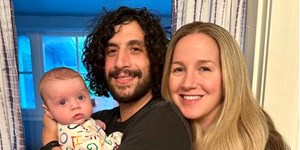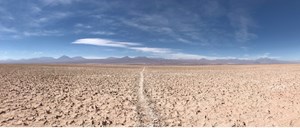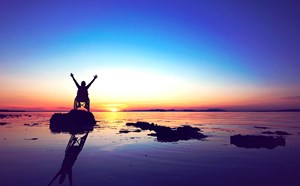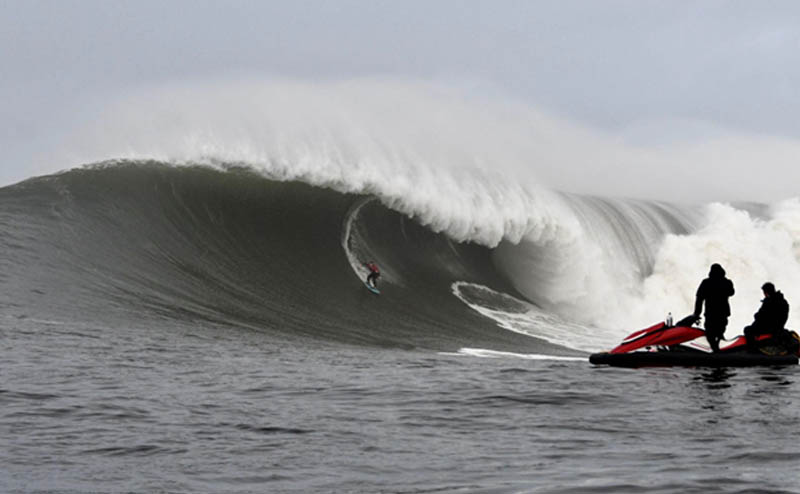
Facing Ocean Monsters to Save Lives: Field Surveillance for Medical Advancement in Big Wave Surfing
All photos are courtesy of Audrey Lambidakis
Jibreel Abdul Cader
Medical Student, UCLA Class of 2027
December 22, 2024 - Half Moon Bay, California
At approximately 4:00 AM, I bid farewell to my in-laws’ home in the South Bay, a cup of scalding coffee burning my hand as I stepped into the cold, damp air. The white halo of streetlights blurred into the red of stoplights through the heavy mist. I mentally ran through my checklist: life preserver, medical go-bag, C-collar, airway adjuncts, BVM, aluminum blanket - all packed. Satisfied, I climbed into my 2001 Toyota Land Cruiser, set “Lenny” by Stevie Ray Vaughan on the stereo, and began the drive through the Santa Cruz Mountains. Pockets of fog and mist wrapped around me like a shroud.
By first light, I arrived at Half Moon Bay Harbor. The jetties were invisible. The fog pulsed with a hypnotic rhythm - 20-24 second intervals, four to six wave sets. I couldn’t see the waves, but I could feel their size. They were massive.
Half Moon Bay is a sleepy coastal town for most of the year, coming alive only in the summer when Silicon Valley families escape the city for clam chowder and fish and chips. But in winter, when the swell hits right, it transforms into something else entirely. When the stars align, hell-bent surfers descend on this coast to challenge the monster waves of Mavericks.
Mavericks is legendary. Named after a dog who frequented Pillar Point in the 1960s, it’s become California’s most iconic big wave spot. When it’s firing, the best big wave surfers on Earth - alongside local diehards - gather in its deep-water lineup.
Why I was there: to conduct field surveillance of world-class big wave surfers in the most dangerous and storied arena in California surfing. Recent research had uncovered a troubling trend: lifetime accumulations of head trauma and brain injury among these athletes, long hidden under cultural taboos. Now, legends of the sport were beginning to speak out. My goal was to understand these injuries and identify opportunities for improving EMS and pre-hospital care. Specifically, we wanted to explore trauma from water impact, a force often underestimated. Having surfed for years, I knew firsthand that falling at high velocity into water can feel indistinguishable from hitting concrete. Yet, no study had ever fully examined this.
Joining our expedition were Dr. Kalvis Hornburg, an Emergency Medicine resident at Stanford, who attended Columbia for medical school and received his degree in Neurobiology with a minor in global health from Harvard; and Audrey Lambidakis, a surf industry insider, professional photographer, and founder of Healing Brainwaves Foundation, a nonprofit advancing access to TBI recovery tools for athletes and the public.
At the harbor, we met our captain: a wiry, sharp-eyed man with more than 50 years on the water. His weathered fishing coat and blue cap, embroidered with crooked orange thread reading “CAPTN,” told the story of a thousand trips to sea. Fish guts, oil stains, and stories hung off him like barnacles. Then there was Frank- in his 50s, battle-tested, Mavericks veteran. His 12-foot gun surfboard was a weapon in itself, built to ride waves 20 feet and up. Beneath his rough exterior was the weight of family obligations and financial strain, but he was eager to share his knowledge and history with us.
We also met “the Veteran” - also mid-50s, silver-haired, wearing a “Gun Runners Surf Club” trucker hat. He was part of a project using Mavericks as surf therapy for veterans with PTSD. Despite being deconditioned, he was also the calmest, reflecting his years overseas. This was far from the scariest thing he had seen. His grin never left his face
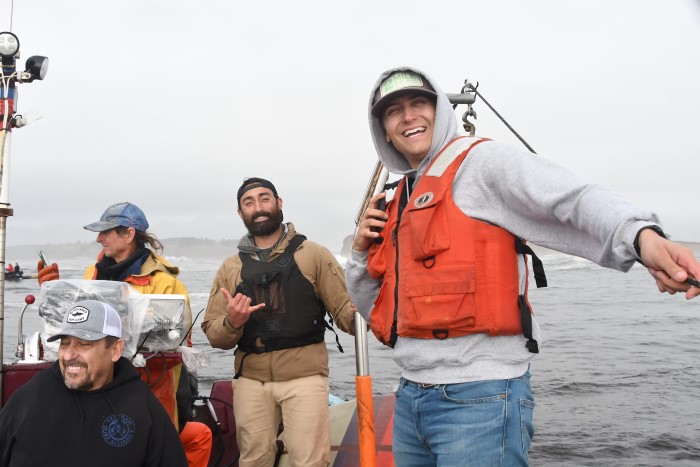
The boat, maybe 16 feet long, was seafoam blue green with a magenta-sealed rubber interior and rust-lined benches. Oil pooled on the floor, soaking into my boots. It smelled of diesel and decades of crabs. This was no rescue skiff; it was a workhorse, and today, it would carry us into mountains of water.
The engine choked and failed - once, twice, again. I raised an eyebrow. Was this really the vessel we were counting on?
On the fifth try, the engine groaned to life, and we set off into the abyss.
As we motored into the fog, visibility dropped to 30 feet. Refracted waves rebounded off the jetties from every direction. My vestibular system, normally steady, was pushed to its limits. The fog, the fumes, and the swell collided into a nauseating sensory overload. We crawled forward toward the deep-water channel.
And then, like parting curtains, the fog lifted. What emerged were towering, smooth, glassy walls of water, 15-20 feet tall, rising in open ocean like liquid buildings. These weren’t breaking yet, just flexing. As a surfer, my instinct was to sprint to the horizon - to escape the impact zone. But this was the horizon. There was no escape.
The water churned with reddish-brown sediment stirred up from the deep. We approached Mavericks from the south shoulder, weaving between sets. The famous Pillar Point Air Force Base radar dome loomed in the distance. So did the “Graveyard” - shed-sized rocks that spelled doom for surfers caught inside.
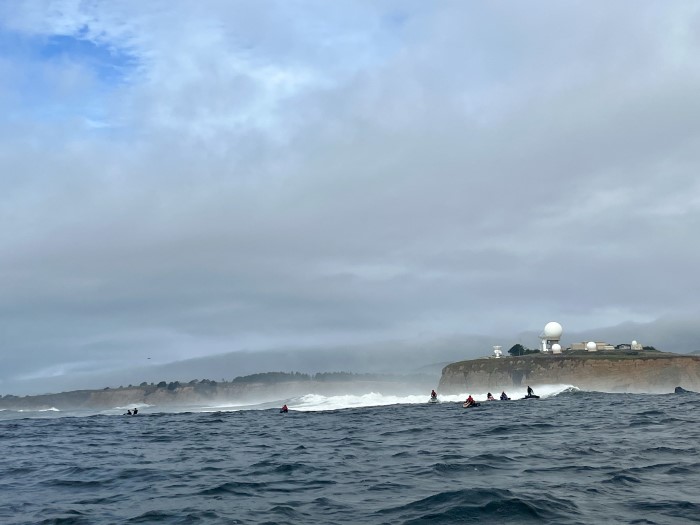
Within 500 yards of the break, the scene was organized chaos: jet skis, tow surfers, paddlers, and the elite water rescue team of Frank Quirte and Drake Stanley zipped between them. They wore wetsuits and fins, and carried the poise and calm of professionals. You could see the focus in their posture, even if their dark sunglasses hid their emotions.
The banter stopped when the first wave rolled in. It looked like a moving mountain. Tow surfer, Luca Padua, dropped in, cutting across the face of the wave. When he let go of the rope, the wave pitched and detonated. For a moment, he vanished in a white explosion. Then, he emerged, like an alpine snowboarder outrunning an avalanche. The channel erupted in cheers. Luca beat his chest. A war cry.
 Luca's ride
Luca's ride
The rest of the day unfolded in a blur of speed and sound. Surfers paddled into waves the size of office buildings. One ride, in particular, stood out. A young up-and-coming surfer, Nathan, had chosen to paddle that day; a daunting choice, given the speed and steepness of the waves. Paddle surfers rely solely on their own strength to match the momentum of these unbroken walls of water, trying to reach sufficient speed in the narrow 3-5 second window before the wave crests and pitches a five-foot-thick lip forward-often throwing as far as it is tall.
We watched as Nathan eyed a wave approaching from the horizon. He turned, dropped his head, and paddled with his whole heart. He accelerated from a 20 mph sprint into a 45 mph freefall down a near-vertical face, knifing down the slope as he tried to maintain control. But the wave’s speed was too great. In seconds, his board was ripped from beneath him. He tumbled head over heels, cartwheeling in the belly of the wave; three full rotations without ever breaking the surface.
Then he vanished. His body was absorbed into the pitching lip as it detonated, slamming him to the depths. It was a violence of water unlike anything I had ever seen.
Twenty seconds later, Nathan emerged from the frothy white turbulence, having inflated his rescue vest. Only half of his board remained. Split clean down the middle, the other half would later wash in toward the shore.
We watched incredible rides, brutal wipeouts, snapped boards, and quiet triumphs.
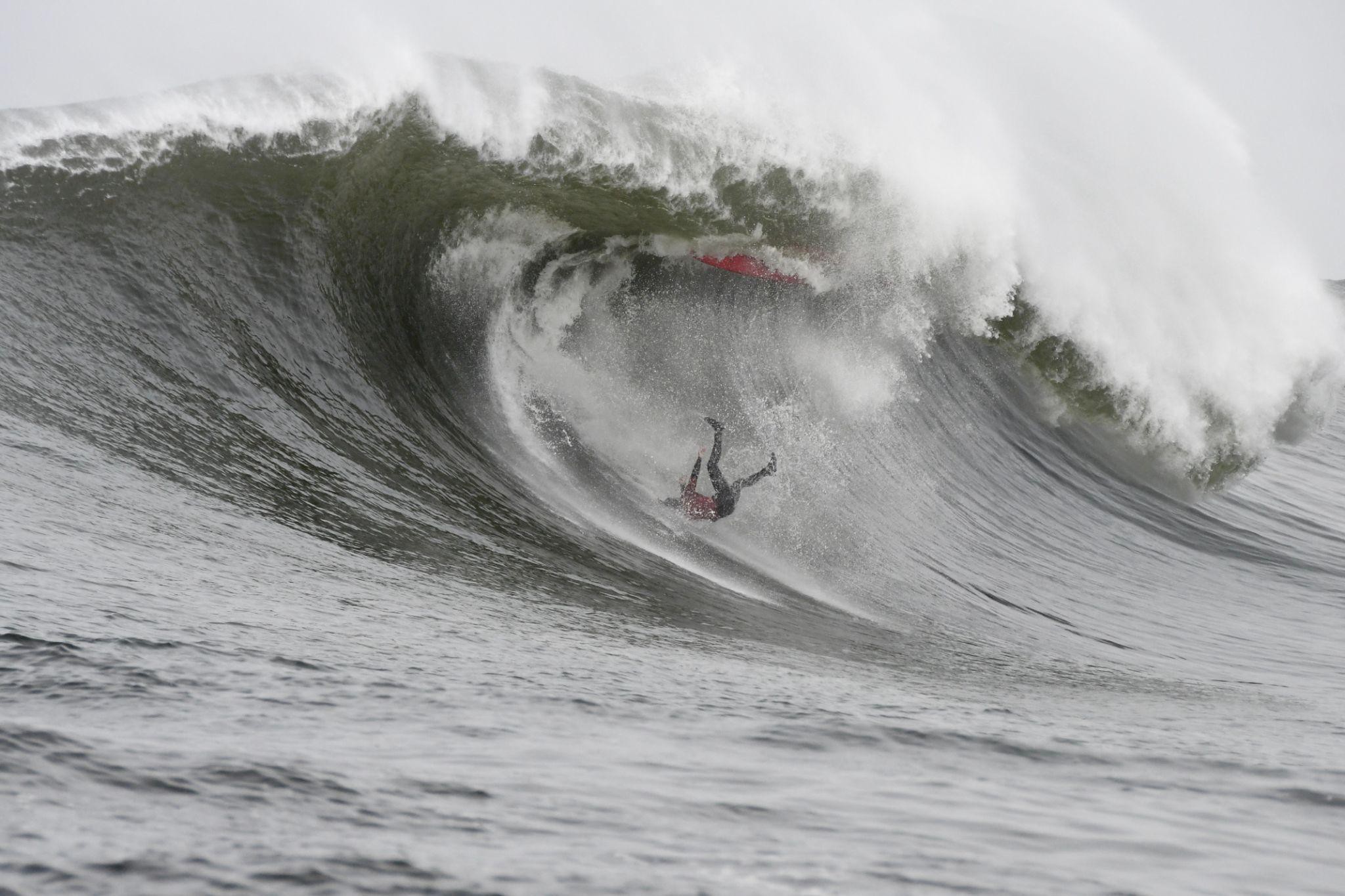 Nathan’s wipeout
Nathan’s wipeout
As the afternoon progressed, winds turned side-offshore and the sun began to hang lower in the sky. The surface grew bumpy and treacherous. The once bustling crowd had now thinned as many who had been surfing since the early morning went in. Our engine coughed again, twice. I checked the horizon with concern.
The sets seemed to be fewer and farther between with the tide shift. We were still expecting more action, as tomorrow was supposed to be substantially larger than today, with even more swell on the way. But it became eerily still. Our captain took this time to enjoying his late lunch sandwich as he called his sweet wife who greeted us all over the phone and they spoke casually as if he wasn’t doing some death defying act of navigating a small craft in seas the size of mountains and getting as close as possible to them so that our photographer could capture them in as high quality as possible.
Then, it happened.
From the corner of my eye, a darkness grew.
A massive set approached swinging wide angled, further from the south, 40 feet, and was building fast. “Captain! Captainnnn!” we shouted. We were squarely in its path. He tried the ignition - nothing. Again - nothing. On the third try, the engine roared to life, and we surged forward.
There was no shoulder to flee to. We aimed directly at the wave.
We climbed. We gripped the rail of the small boat as it climbed the face of the mountain. Climbing. Climbing. Still climbing. Like a roller coaster ride, we went from flat to steep, to steeper, to downright vertical. I looked back and saw the trough like the mouth of a beast. We barely crested the wave - spray flying, hearts pounding - before crashing down its backside. Another wave loomed, but we were already running.
We limped to the deep-water channel. Safe. For now.
Late afternoon winds became too strong to justify staying out, and we planned to head into the harbor as the still-growing swell and now onshore winds may make the channel pass back to the harbor dangerous with larger sets washing throughout he channel, claiming any vessels with it. We timed the sets and high-tailed to the channel.
Weaving through the football-field-wide channel entrance demarcated by two buoys, each circled by sea lions. We made it to the channel.
Something possessed me to turn around as the golden late afternoon ocean spray of 20 knot winds and a full throttle small engine blaring filled the senses. I looked back. A 40ft set cresting at the mouth of the channel as we raced toward shore.
I said nothing to the others. No point in telling the captain, he knew. The rest of the crew? What would be the point? Panic?
I watched the set track behind us: 1000 yards, 750, 500, 250. It crested and broke into a 30ft wall of water, an avalanche, a stampede.
I gripped the rail. If it caught us, we’d flip. 100 yards. 50 yards.
My eyes flashed to shore. Could I swim the 1.5 kilometers to shore in these conditions? That wasn't the question. The real question was, would I have to?
50 yards.
50 yards.
Was it slowing? Was it backing off?
And then, the wave backed off. Like a beast no longer intrigued by the chase of a small prey. Dissipated into the deep-water pocket beneath us. A near mythical save by the seafloor itself.
We cruised into the now clear and quiet harbor under golden light. The water stilled. It felt like a sanctuary.
Later, at Old Princeton Landing - “OPL” to locals - we gathered with surfers and photographers. They shared stories, watched footage, and streamed the Eddie Aikau Invitational in Hawai‘i, where surfers were riding on the very swells that would arrive on California’s coast late tomorrow. I used the opportunity to ask questions about safety, concussions, and emergency plans.
What we learned was sobering. The rescue and water safety teams were experienced, skilled, and deeply committed- but entirely volunteer-run and underfunded. Their protocol ended at a 911 call. Nearly every surfer we interviewed reported at least one concussion from surfing, many undiagnosed. One surfer, an engineer, and a previous academic, Tanner, spoke to me about his story. He suffered a severe concussion while big wave surfing out of state, which greatly impacted his quality of life. He said, “I wouldn’t be here without Audrey and her work.” He was referring to the Healing Brainwaves Foundation, which, like many other surfers afflicted by brain injury before him, connected him with critical recovery resources and longitudinal observation to ensure he didn’t fall through the cracks of our complex care system.
Inspired by this experience, and drawing on my own story, I’m now leading a research study at UCLA. With IRB approval and recruitment underway, we aim to quantify the environment big wave surfers endure, track their physiologic responses throughout the winter swell season, and determine concussion prevalence using wearable sensors and validated screening tools. We hypothesize that surfers may exhibit changes in concussion metrics or biometric data after a major wipeout.
Our hope is that this research will influence cultural and competitive norms in the sport. That it will improve injury recognition, increase awareness, and expand protection for surfers worldwide. Because, as thrilling as it is to face ocean monsters, it shouldn’t come at the cost of the throne upon which your consciousness rests.

